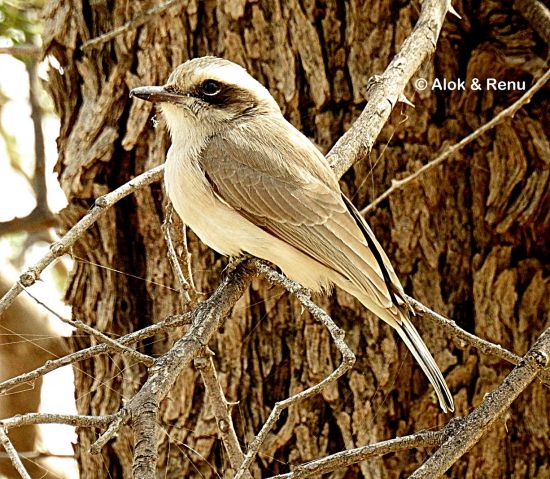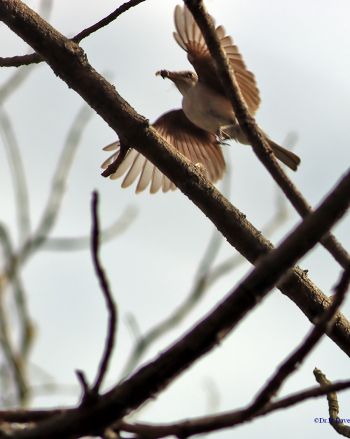
Photo by Alok Tewari
Talchhapar Blackbuck Sanctuary, Churu, Rajasthan, India, 24 February 2022
- Tephrodornis pondicerianus
Identification
14·5–18 cm (5¾-7 in)
- Brownish-grey upperparts and wings
- White underparts
- Dark brown patch behind eye
- White supercilium
- Greyish-brown lores
- Dark brown tail
- Yellowish-brown iris
- Grey legs and bill
Distribution
Taxonomy
Sri Lanka Woodshrike T. p. affinis has been split from this species.[1][2]
Subspecies
Three subspecies are recognized:[1]
- T. p. pallidus
- T. p. pondicerianus
- T. p. orientis
Habitat
Open and dry deciduoous forests, secondary growth, bamboo, woodland, hedgerows, gardens and groves.
Behaviour
Arboreal.
Diet
They feed on insects, particularly beetles, spiders and some fruit.
Breeding
The nest, constructed by both adults, is cup shaped and made from moss, lichen, roots, grass and bark, bound with spider's webs and lined with hair and wool. The clutch consists of 2-3 cream, yellow or reddish brown spotted eggs.
References
- Clements, J. F., T. S. Schulenberg, M. J. Iliff, T. A. Fredericks, J. A. Gerbracht, D. Lepage, S. M. Billerman, B. L. Sullivan, and C. L. Wood. 2022. The eBird/Clements checklist of Birds of the World: v2022. Downloaded from https://www.birds.cornell.edu/clementschecklist/download/
- Gill, F and D Donsker (Eds). 2010. IOC World Bird Names (version 2.7). Available at http://www.worldbirdnames.org/.
- Whistler, H. 1949. Popular Handbook of Indian Birds.
- Handbook of the Birds of the World Alive (retrieved October 2016)
Recommended Citation
- BirdForum Opus contributors. (2025) Common Woodshrike. In: BirdForum, the forum for wild birds and birding. Retrieved 5 February 2025 from https://www.birdforum.net/opus/Common_Woodshrike
External Links
GSearch checked for 2020 platform.




